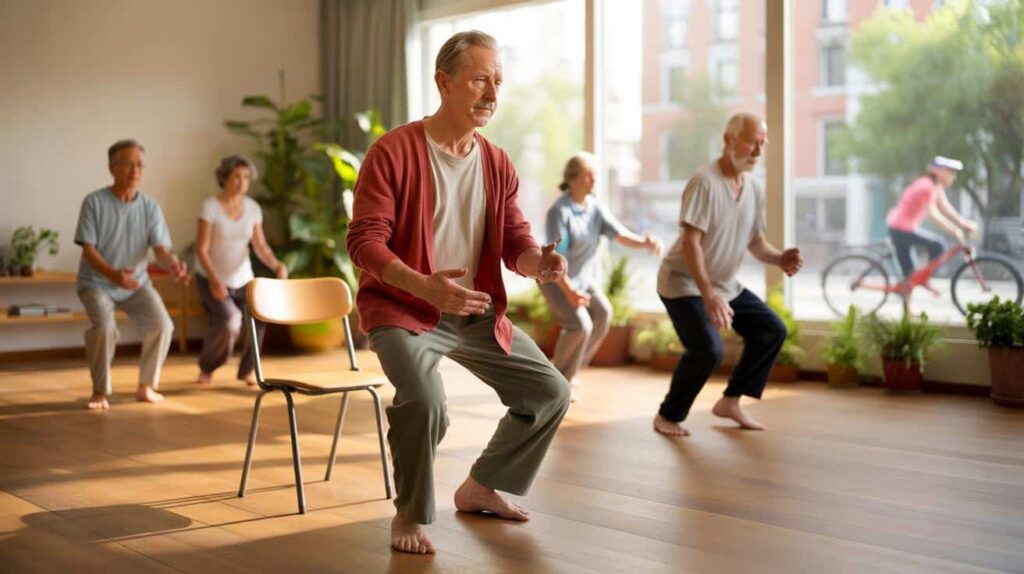Your knees ache getting out of a chair, and everyone says the same two things: bike or swim. What if the fix that actually works after 60 happens in a quiet room, on dry land, in slow motion?
A dozen people stood in a loose circle, palms floating, eyes soft, knees bent just enough. The instructor cued a shift of weight from heel to ball, and the room moved like sea grass. A man in a red cardigan, mid‑60s, rolled his shoulders and breathed as if the whole building had exhaled with him.
Everything slowed until you could hear your own joints say thank you. A woman whispered, “This is the first time my knee hasn’t argued today,” and smiled without looking down. Outside, cyclists zipped past the windows. In here, the power came from going slow. The trick wasn’t speed.
The overlooked fix on dry land: tai chi for angry knees
Forget laps and spin classes for a second. The surprising ally for stubborn knee pain after 60 is **tai chi**—slow, flowing patterns that teach your legs to share the workload instead of letting one joint take the hit. It looks gentle. It is. Yet it quietly builds strength where older knees need it most: around the hips, thighs, and ankles.
Each shift of weight is a lesson in micro-adjustment. When the front knee bends a little and the back heel releases, the quadriceps engage without a jolt, the glutes wake up, and the small stabilizers around the kneecap learn to guide rather than grab. It’s like oiling the hinges, not slamming the door. We’ve all had that moment when a step feels risky; tai chi turns that moment into a practiced, safe move.
For older adults living with **knee osteoarthritis**, the evidence is surprisingly solid. In one well-known trial with people in their 60s and 70s, a 12-week tai chi program cut knee pain and boosted daily function about as much as structured physical therapy. Participants also reported better mood and balance, which matters when fear of falling keeps you from walking far. Less fear equals more movement—and more movement often equals less pain.
What to do today: a 10-minute flow your knees will tolerate
Start with breath. Stand near a chair for light support, feet hip-width, toes forward. Soften the knees, then inhale three counts as you shift weight to your right foot; exhale three counts as you settle to the left. Add “cloud hands”: palms level with your belly, drifting side to side as your weight flows. Finish with slow sit-to-stand from the chair, using your hips, not your knees, to drive up. Ten minutes is plenty.
A few friendly guardrails simplify things. Keep the knees tracking over the second and third toe, not caving inward. Shorten your stance if the front knee feels pressured. Flat, flexible shoes or barefoot on a safe surface help you feel the floor. Think “glide, don’t sink.” Aim for a light, warm ache in the thighs, not a stab in the joint. Soyons honnêtes : personne ne fait vraiment ça tous les jours. Two or three short sessions a week beats a single heroic effort.
Common sticks in the spokes are almost always fixable. Going too low, too soon turns a knee-friendly move into a grind; stay in a small, comfortable bend and let range grow over weeks. Twisting on a planted foot is a no-go; pivot from the hip or lift the heel to follow your turn. And if balance is wobbly, make the chair your anchor rather than a test of pride.
“Soft knees, strong hips, quiet feet,” says Lena, a tai chi teacher who started after her own meniscus tear at 58. “When the hips lead, the knees stop shouting.”
- Keep knees behind toes in deeper bends.
- Shift weight fully before stepping.
- Move slow enough to notice tension—and release it.
- Stop at pain 3/10; back off if it spikes.
- Finish with gentle ankle circles to “rinse” the joints.
Why slowing down pays off after 60
Muscles are shock absorbers for your knees. Tai chi turns them back on without the pounding that makes you pay tomorrow. By teaching your body to load through the hip, then knee, then ankle—like a wave rolling to shore—it spreads force instead of dumping it on one sore spot. The result is less compression at the joint and fewer flares after you move.
There’s a brain piece too. Pain makes us guard, and guarding stiffens everything. Gentle, repeating patterns rewire that reflex. You relearn that bending doesn’t equal danger, which quiets pain signals and restores your natural gait. It also nudges your balance system into shape, cutting the risk of falls that often follow knee pain like a shadow.
And it’s social, which matters more than it sounds. People show up for the moves and stay for the laughter after class, the “how’s your knee today?” at the door. That low-stakes accountability makes consistency possible. The truth is, consistency beats intensity **after 60**—and tai chi is built for showing up again tomorrow.
The small routine that changes how you walk the rest of the day
Try this kitchen-counter sequence. Hold the edge lightly. Do five slow weight shifts each side. Step forward into a narrow stance and bend both knees a touch—think elevator, not escalator—then float back. Repeat three times per side. End with heel raises for 10 breaths, lowering as slowly as you lifted. The whole thing takes less time than waiting for the kettle.
On days your knee is grumpy, scale back rather than quit. Shrink the bend, shorten the step, increase the breath. If an exercise pokes the joint, swap it for an easier cousin; “cloud hands” instead of deep lunges, standing march instead of long steps. Keep your wins visible: a sticky note on the fridge, a tick on a calendar, a quick text to a friend. That’s how tiny sessions add up to lighter stairs and easier mornings.
One more perspective on progress. Pain that narrows or fades during a session is usually your green light; pain that grows sharper is a red flag to pause and recalibrate. The goal isn’t to “push through.” It’s to build options.
“I started for my knee,” says Marco, 71. “I stayed because I could pick up my granddaughter without thinking about it.”
- Start where you are, not where you were.
- Use a chair, wall, or rail for balance any time.
- Breathe through the move; don’t hold it.
- Keep sessions short, repeat often.
- Celebrate function, not perfection.
The bigger picture: movement that lowers the volume on pain
Say you begin with ten minutes, three days a week. A month later, stairs feel less like a summit attempt. Two months in, you notice your stride is longer, and your foot finds the floor with more confidence. Little by little, knees stop running the show. You start planning your day around what you want to do, not what hurts less.
This is the quiet magic of slow, mindful movement. It trades drama for traction. It invites your nervous system to drop its shoulders, and your joints to move like parts of the same team. Maybe that’s why tai chi classes fill with people who never saw themselves as “exercise types.” It’s movement with dignity, and that sticks.
Some readers will try a YouTube class tonight. Others will pencil a local group for next week. Neither is right or wrong. The only wrong step is the one your knee dreads. Pick the path your body doesn’t argue with, then walk it a little farther than yesterday. The rest is just practice.
| Point clé | Détail | Intérêt pour le lecteur |
|---|---|---|
| Tai chi, not laps | Slow, weight-shifting patterns reduce joint stress | A realistic path to less knee pain without a pool or bike |
| 10-minute starter | Breath, weight shifts, cloud hands, sit-to-stand | Immediate, doable routine for today |
| Safety cues | Knees track over toes, small bends, no twisting on a planted foot | Move with confidence and avoid flare-ups |
FAQ :
- Is tai chi safe if I have knee arthritis?Yes, when kept within a small, pain-tolerated range. Many studies show reduced pain and better function with gentle, progressive practice.
- How often should I do it to feel a change?Two to three short sessions per week can help within 3–4 weeks. Most people notice smoother stairs or easier standing by week six to eight.
- What if I can’t stand for long?Do the upper-body patterns seated and practice weight shifts with one hand on a counter. Build up in 60–90 second chunks.
- Will it help with balance too?Yes. The slow transfers of weight train your ankles, hips, and inner ear to coordinate, which often reduces stumbles and fear of falling.
- Do I need special shoes or gear?No. Flexible, flat shoes or barefoot on a safe surface are best. A stable chair or countertop makes a perfect training partner.








